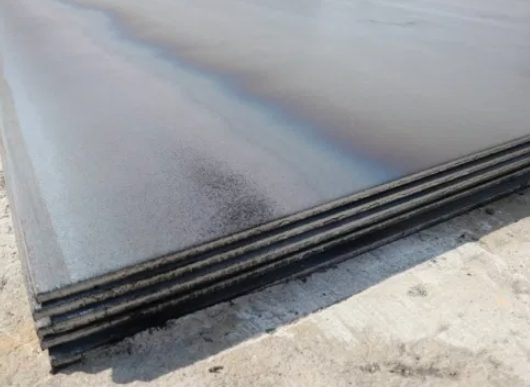Carbon steel plates are typically defined as steels with minimal alloying elements, primarily consisting of carbon (C), manganese (Mn), phosphorus (P), sulfur (S), and silicon (Si). Elements like aluminum (Al), chromium (Cr), nickel (Ni), molybdenum (Mo), vanadium (V), among others, may be present, but there are no strict minimum limits for their inclusion.
These plates are categorized into low, medium, and high carbon grades, with the carbon content influencing the strength and durability of the plate. Variations in thickness, usage, and formation process further classify them into sub-categories. Generally ranging from 0.4 mm to 80 mm in thickness and 1000 mm to 45000 mm in width, carbon steel plates can extend up to 18 meters in length. However, their length is customizable to suit diverse applications, providing flexibility to customers.
Moreover, carbon steel plates can be processed into cold rolled steel coils, expanding their utility across various industries and applications.

Carbon Steel Plate Classification and Applications
Carbon steel plates are essential components across various industries, categorized based on their carbon content and application suitability.
- Low Carbon Steel Plate:Characterized by carbon content ranging from 0.06% to 0.25%, low carbon steel plates are commonly referred to as mild steel plates. They offer versatility and are widely utilized in numerous applications.
- Medium Carbon Steel Plate:With carbon content typically falling between 0.25% and 0.55%, medium carbon steel plates exhibit enhanced strength and durability compared to their low carbon counterparts.
- High Carbon Steel Plate:Featuring carbon content ranging from 0.55% to 1.0%, high carbon steel plates, also known as hard steel plates, offer exceptional hardness and resilience. They are favored for applications requiring robustness and wear resistance.
The hardness of a steel plate tends to increase with higher carbon content.
Varieties of Carbon Steel Plates and Their Applications:
Carbon steel plates find widespread applications across diverse industries, serving as fundamental materials for component construction in machinery and production sectors. Their durability makes them indispensable for manufacturing various parts.
Additionally, carbon steel plates are further classified based on their specific applications:
- Vessel Steel Plate:Used in the fabrication of pressure vessels and boilers due to their ability to withstand high-pressure environments.
- Shipbuilding or Construction Steel Plate:Employed in shipbuilding and construction projects, these plates offer strength and durability, crucial for maritime and structural applications.
- Structural Steel Plate:Utilized in the construction of buildings, bridges, and other large-scale structures due to their load-bearing capacity and structural integrity.
- Pipeline Steel Plate:Designed for use in the construction of pipelines, ensuring the efficient transportation of fluids and gases across vast distances.
- Stainless Steel Plate:While distinct from carbon steel, stainless steel plates are also widely used, particularly in industries requiring corrosion resistance, such as food processing, chemical, and pharmaceutical sectors.
Carbon steel plates are integral to various industries, offering a range of properties tailored to specific applications, from structural integrity to resistance against wear and pressure.
Different Types of Carbon Steel Plates and Their Applications
- Carbon Structural Steel Plate:Primarily employed in the construction industry, carbon structural steel plates must adhere to the highest standards of quality, durability, and performance. These plates are engineered to withstand heavy loads and pressure while maintaining corrosion resistance. Commonly referred to as construction steel plates, they form the backbone of various structural projects.
- Boiler Steel Plate:Designed for high-pressure applications, boiler steel plates are crucial components in the fabrication of vessels, boilers, and heat containers. These plates exhibit low corrosive tendencies and possess the ability to withstand elevated temperatures. To enhance their suitability for diverse environments, multiple layers of chromium or nickel may be incorporated during manufacturing.
- Tanks Steel Plate:Essential for the construction of storage infrastructure, tanks steel plates find utility in the fabrication of oil and gas tanks, water tanks, and containers for various materials. These plates are engineered to endure the demands of containing liquids and other substances securely.
- Carbon Shipbuilding Steel Plate:Sought after, particularly by the oil and gas industry, carbon shipbuilding steel plates are characterized by their thickness and superior quality. Manufactured according to customer specifications, these plates undergo rigorous certification processes due to the critical nature of their usage. Even minor defects, such as lamellar tears, can pose significant risks in maritime applications. Therefore, stringent quality control measures ensure the integrity and reliability of these plates for shipbuilding purposes.
Various Standards for Carbon Steel Plates
Carbon steel plates adhere to numerous standard specifications, encompassing a broad range of applications in diverse industries.
- ASTM A36 Plates:Widely recognized as the most common standard for carbon steel plates due to its versatility and suitability for various structural applications.
- ASTM A283 Grade A, B, C:Another prevalent material in the realm of carbon structural steel, offering reliable performance across a spectrum of applications.
- ASTM A516:Designed specifically for boiler and vessel steel plates, meeting stringent requirements for pressure vessel applications.
- ASTM A537:Tailored for heat-treated carbon steel plates used in fusion welded pressure vessels and structural steel applications.
- ASTM A573:Features carbon-manganese-silicon composition, rendering it suitable for structural steel plate applications.
- ASTM A572:Renowned for its superior mechanical strength compared to A36, making it ideal for applications where weight reduction is crucial.
- ASTM A737:Geared towards low alloy steel plates used in boiler and pressure vessel applications, ensuring durability and reliability under extreme conditions.
These standards represent just a fraction of the comprehensive coverage provided by carbon steel plates across various industries.
CG Steel offers an extensive selection of carbon steel plates at competitive prices from China. Should you require any of the aforementioned plates for your projects, feel free to reach out to us for attractive offers and superior service.








